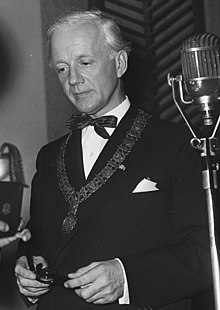
Jelle Zijlstra was a Dutch politician of the defunct Anti-Revolutionary Party (ARP) now the Christian Democratic Appeal (CDA) party and economist who served as Prime Minister of the Netherlands from 22 November 1966 until 5 April 1967.

Willem Drees Sr. was a Dutch politician of the Social Democratic Workers' Party (SDAP) and later co-founder of the Labour Party (PvdA) and historian who served as Prime Minister of the Netherlands from 7 August 1948 to 22 December 1958.
The Government of Amsterdam consists of several territorial and functional forms of local and regional government. The principal form of government is the municipality of Amsterdam, Netherlands. The municipality's territory covers the city of Amsterdam as well as a number of small towns. The city of Amsterdam is also part of several functional forms of regional government. These include the Waterschap of Amstel, Gooi en Vecht, which is responsible for water management, and the Stadsregio of Amsterdam, which has responsibilities in the areas of spatial planning and public transport.

Jan Lievens was a Dutch Golden Age painter who was associated with his close contemporary Rembrandt, a year older, in the early parts of their careers. They shared a birthplace in Leiden, training with Pieter Lastman in Amsterdam, where they shared a studio for about five years until 1631. Like Rembrandt he painted both portraits and history paintings, but unlike him Lievens' career took him away from Amsterdam to London, Antwerp, The Hague and Berlin.
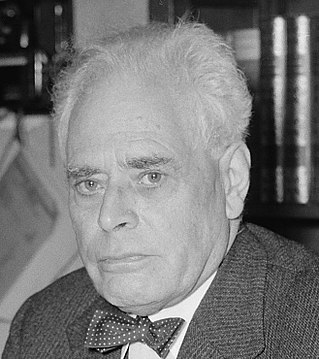
Pieter Jacobus Oud was a Dutch politician of the defunct Free-thinking Democratic League (VDB) party and later co-founder of the Labour Party (PvdA) and the People's Party for Freedom and Democracy (VVD) and historian. He was granted the honorary title of Minister of State on 9 November 1963.

Johannes "Jan" van Aartsen was a Dutch politician of the defunct Anti-Revolutionary Party (ARP) now merged into the Christian Democratic Appeal (CDA) party and jurist.

George Wilhelm Kettmann or George Kettmann Jr. was a Dutch poet, writer, journalist and publisher who promoted Nazism in the Netherlands. With his wife, he founded the best known Dutch Nazi publishing house, De Amsterdamsche Keurkamer. Until 1941 he was editor in chief of Volk en Vaderland, the weekly journal of the National Socialist Movement in the Netherlands (NSB), the movement of Anton Mussert.
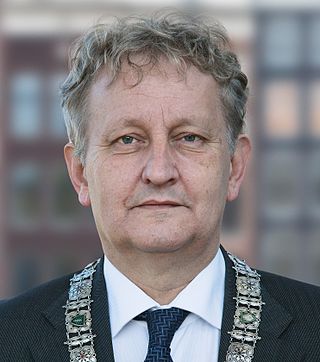
Eberhard Edzard van der Laan was a Dutch politician who served as Minister for Housing, Communities and Integration from 2008 to 2010 and Mayor of Amsterdam from 2010 until his death in 2017. He was a member of the Labour Party (PvdA).

Jacobus Albertus Wilhelmus "Jaap" Burger was a Dutch politician of the Social Democratic Workers' Party (SDAP) and later co-founder of the Labour Party (PvdA) and jurist. He was granted the honorary title of Minister of State on 4 January 1975.

Ivo Samkalden was a Dutch politician of the Labour Party (PvdA) and jurist. He was granted the honorary title of Minister of State on 22 January 1985.

Antoon Arnold Marie "Teun" Struycken was a Dutch jurist and politician, co-founder of the Catholic People's Party (KVP) – now merged into the Christian Democratic Appeal (CDA).

Joris in 't Veld was a Dutch politician of the Social Democratic Workers' Party (SDAP) and later the Labour Party (PvdA) and jurist.

The National Monument on Dam Square is a 1956 cenotaph in Amsterdam, Netherlands. A national Remembrance of the Dead ceremony is held at the monument every year on 4 May to commemorate the casualties of World War II and subsequent armed conflicts.

Wilhelmina Drucker was a Dutch politician and writer. One of the first Dutch feminists, she was also known under her pseudonyms Gipsy, Gitano, and E. Prezcier.

Frederick "Rick" van der Ploeg is an Anglo-Dutch economist and former politician.
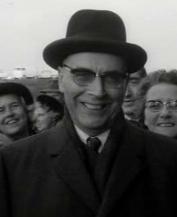
Gijsbert van Hall was a Dutch banker, resistance member and senator. He was Mayor of Amsterdam between 1957 and 1967.
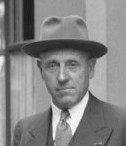
Jan van Tilburg was a Dutch politician for the Labour Party who was a member of the Senate between 1951 and 1955 and Governor of Suriname between 1956 and 1962. During his tenure in government, the Brokopondo Reservoir was created to supply electricity for the Suralco aluminium plant.

Gisèle d'Ailly van Waterschoot van der Gracht, also known by the mononym Gisèle, was a Dutch visual artist. During World War II, she operated a safe house out of her home for a group of young Jewish people in Amsterdam.
Isaac de Roever was a Dutch politician, who served as acting governor-general of the Dutch Gold Coast between 28 April 1804 and 16 June 1805, and as mayor of Diemen.
